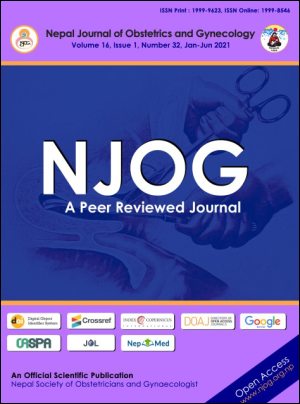Robson Ten Group Classification System and fetal distress as the indication for cesarean section
Keywords:
cesarean section, fetal distress, indication, Robson classificationAbstract
Aim: To determine the association of Robson ten group classification system (RTGCS) and the fetal distress as an indication of CS among women delivering in Paropakar Maternity and Women’s Hospital.
Methods: This was an observational cross-sectional study over a period of 6 months. 410 study sample population undergoing CS were stratified according to RTGCS out of total of 11575 women’s delivering in PMWH and were analysed for indication of CS, fetal distress, maternal and fetal complications and their distribution according to RTGCS.
Results: Overall CS rate was 35.08%. Largest group size was of group 1 with 4131 patients (35.69%) followed by group 3 with 2980 patients (25.75%). Highest contribution to CS rate was from group 5 (1070 patients, group CS rate 99.17% and contribution to overall CS rate 26.35%). Group 1 and 2 had low group CS rate in comparison to other groups but it was still higher than the Robson guidelines and MCS reference population as per WHO implementation guidelines. On analysis of sample study population CS rate due to fetal distress was 28.54% and previous CS was 25.85%.
Conclusions: High proportion of women gave birth via CS among which high contribution was by low risk groups. The major indication of CS in low risk groups was fetal distress and there was significant rise of fetal distress after admission. Hence RTGCS neither could predict the indication of CS nor could correctly identify the actual high risk group. Hence incorporation of more objective indication of CS like fetal distress or high risk diagnosis which gives rise to fetal distress, in RTGCS criteria is recommended.
Downloads
Downloads
Published
How to Cite
Issue
Section
License
Copyright (c) 2021 Alish Shrestha, Gehanath Baral

This work is licensed under a Creative Commons Attribution-NonCommercial 4.0 International License.
Copyright on any research article in the Nepal Journal of Obstetrics and Gynaecology is retained by the author(s).
The authors grant the Nepal Journal of Obstetrics and Gynaecology a license to publish the article and identify itself as the original publisher.
Articles in the Nepal Journal of Obstetrics and Gynaecology are Open Access articles published under the Creative Commons CC BY-NC License (https://creativecommons.org/licenses/by-nc/4.0/)
This license permits use, distribution and reproduction in any medium, provided the original work is properly cited, and it is not used for commercial purposes.



